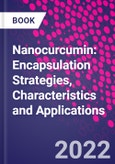With an aim of informing people in academia or those who work on the encapsulation of poorly soluble bioactives (beyond curcumin) for food formulations and the development of functional foods and food nanotechnology, this book provides extensive and advanced knowledge on the field.
Table of Contents
Section 1: Curcumin and nanocurcumin: Chemistry, properties and applications1. Introduction
2. Curcumin: Chemistry, properties and health effects
3. Nanocurcumin: Concepts, nanoencapsulation strageties and bioaccessibility/bioavailability
4. Digestion, adsorption and metabolism of nanocurcumin
Section 2: Polymeric nanostructured carriers for curcumin
5. Food protein nanocomplexes as nanocarriers for curcumin
6. Protein-based nanoparticles as carriers for curcumin (emulsification and evaporation)
7. Self-assembly of milk proteins for nanoencapsulation of curcumin
8. Self-assembly of plant proteins for nanoencapsulation of curcumin
9. Alcohol-soluble proteins as nanosized delivery systems for curcumin
10. Carbohydrate-based nanoparticles as nanocarriers for curcumin: Fabrication and properties
11. Protein-polysaccharide nanocomplexes or hybrid nanoparticles as nanocarriers for delivery of curcumin
12. Electrospun nanofibers or nanoparticles as carriers for curcumin
Section 3: Lipid-based nanostructured systems for delivery of curcumin
13. Food-grade nanoemulsions: Fabrication, challenges and applications as delivery systems of curcumin
14. Solid lipid nanoparticles as nanodelivery systems for curcumin
15. Food grade Pickering emulsions as delivery systems for curcumin
Section 4: Development and challenges of nanocurcumin for functional food and pharmaceutical industry
16. Spray-dried nanocurcumin as functional food ingredients
17. Targeted delivery and controlled release of nanocurcumin








